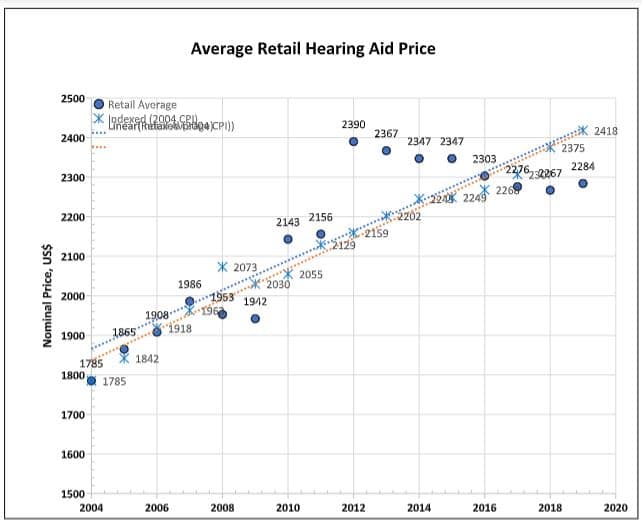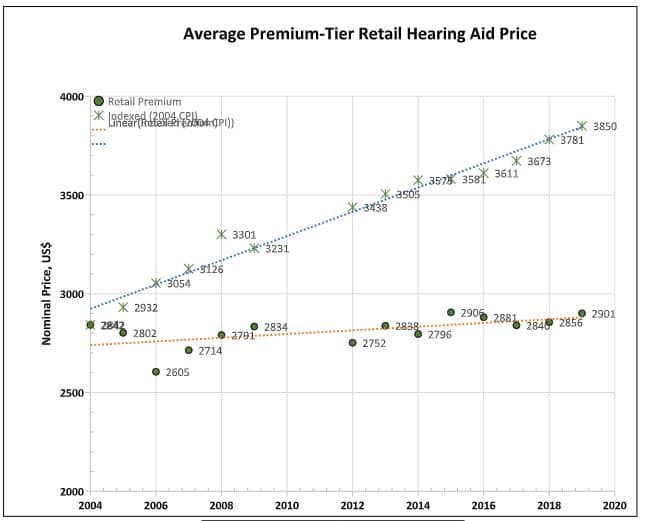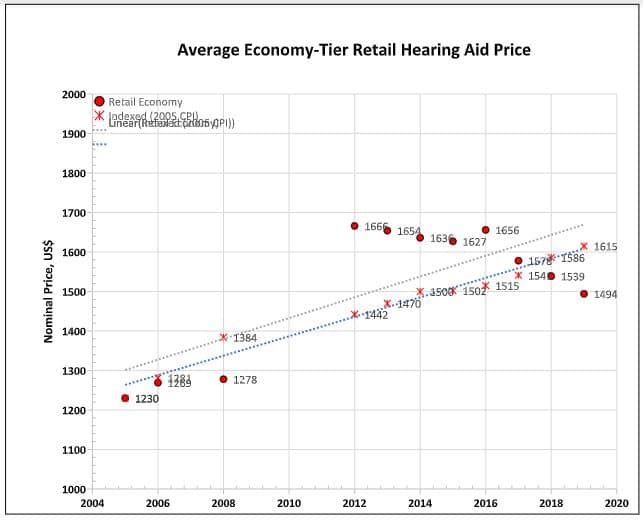In our series on hearing aid pricing, readers have been provided with data on average nominal (Part 1) and inflation-adjusted (Part 2) wholesale hearing aid price, and, more recently, with average nominal retail hearing aid pricing (Part 3). In the fourth installment of this series, the reader is presented with a comparison between unadjusted and inflation-adjusted average retail cost of a single unit device over time.
CPI… A Reminder
Historical changes in US inflation are captured by the US Bureau of Labor Statistics and reported as the Consumer Price Index (CPI). CPI data allows for the assessment of whether a good or service has increased or decreased in price compared to the same good service at another point in time.
Average Hearing Aid Retail Pricing

Figure 1. Comparison between unadjusted, average, single-unit retail hearing aid prices (blue filled circles), in US dollars, and a 2004 average-priced, single unit retail hearing aid adjusted for inflation (blue asterisks) across all technology tiers.
- As shown in Figure 1, the average retail cost for a single unit hearing aid was $1785 in 2004. In 2019, the average retail cost for a single unit hearing aid was $2284, unadjusted for inflation. Over time, the average retail cost per unit increased by $499, or an annual average increase of $32.27.
- When CPI data are applied to the 2004 retail single unit cost (i.e., $1785), the average cost of a single unit hearing aid in 2019 is yields a value of $2418. This finding indicates that the 2004 unit increased in inflationary cost by $633 in 2019, or at an annual rate of $42.20.
- It should be note that between 2009 and 2016, the unadjusted average retail price was notably higher than the inflation-adjusted average retail price. The difference was greatest in 2012, when unadjusted retail pricing exceeded inflation-adjusted pricing by $231.
- It will be interesting, in time, to track whether the unadjusted average retail price remains below inflation. This trend began in 2017 and continues through 2019, as seen in Figure 1.
Premium-Tier Retail Pricing

Figure 2. Comparison between unadjusted, average, single-unit retail hearing aid prices (orange filled diamonds), in US dollars, and a 2004 average-priced, single unit retail hearing aid adjusted for inflation (orange asterisks) for the premium-technology tier.
- In 2004, the average retail cost for a single unit, premium-tiered hearing aid was $2842 (Figure 2). In 2019, the average retail cost for a similar technology-tier hearing aid was $2901, unadjusted for inflation. Over this span, the average retail cost per unit increased by $59, or by an annual average of < $4.00.
- When CPI is applied for inflation, the 2004 price tag of $2842 had ballooned to an average cost per single unit to $3850 in 2019. This translates to a difference of $949, yielding an annual average increase in inflation to the retail price of $63.27.
- Clearly, premium-tier hearing aids are being dispensed at a rate well below that of inflation over time.
Economy-Tier Retail Pricing

Figure 3. Comparison between unadjusted, average, single-unit retail hearing aid prices (red filled squares), in US dollars, and a 2004 average-priced, single unit retail hearing aid adjusted for inflation (red asterisks) for the economy-technology tier.
- As seen in Figure 3, the average retail cost for a single unit, economy-tiered hearing aid was $1230 in 2005. (Note: we do not have data before 2005 for this technology tier.) In 2019, the average retail cost for a similar technology-tier device was $1494, unadjusted for inflation. Over this span, the average retail cost per unit has increased by $264, or by an annual average of $18.86.
- When CPI is applied for inflation, the average cost of a single unit hearing aid in 2019 was $1615. This inflation-adjusted value is $385 above the unit price of $1230 (in 2005), of which $121 can be attributed to inflation.
Looking Ahead
In the final blog in this series (Part 5), we will assess cost-based markups of wholesale to retail pricing.







A personal assistive listening device by William Sound called the Pocketalker Ultra is an excellent device for those with hearing loss. It can be used for one on one conversation and listening to the TV. Joining the Hearing Loss Association of America (HLAA) a non-profit organization for those who speak and listen but experiencing hearing loss.